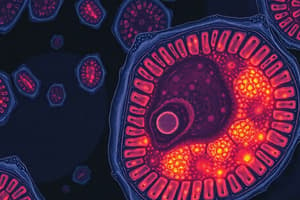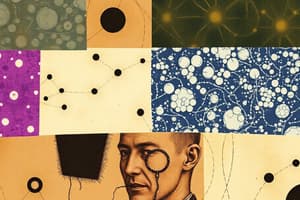Podcast
Questions and Answers
What is the central dogma of molecular biology, and how does it illustrate the unity of life at the cellular level?
What is the central dogma of molecular biology, and how does it illustrate the unity of life at the cellular level?
The central dogma states that genetic information flows from DNA to RNA to protein. This is a universal process shared by all living cells.
Explain how the existence of extremophiles within the Archaea domain challenges our understanding of the conditions necessary for life.
Explain how the existence of extremophiles within the Archaea domain challenges our understanding of the conditions necessary for life.
Extremophiles thrive in extreme conditions such as high temperatures, salinity, or absence of oxygen, demonstrating that life can exist in environments previously thought uninhabitable.
Describe the evolutionary significance of the endosymbiotic theory in the context of eukaryotic cell development.
Describe the evolutionary significance of the endosymbiotic theory in the context of eukaryotic cell development.
The endosymbiotic theory posits that mitochondria and chloroplasts in eukaryotic cells originated as symbiotic bacteria. This explains their double membranes and independent genetic material.
Contrast the cell wall composition of Bacteria and Archaea and explain why this difference is significant.
Contrast the cell wall composition of Bacteria and Archaea and explain why this difference is significant.
Explain how the classification of 'Protista' as a non-monophyletic group impacts our understanding of eukaryotic evolution.
Explain how the classification of 'Protista' as a non-monophyletic group impacts our understanding of eukaryotic evolution.
Describe how the structural diversity of nerve cells (neurons) reflects their specialized function in transmitting electrical signals.
Describe how the structural diversity of nerve cells (neurons) reflects their specialized function in transmitting electrical signals.
Explain the concept of an 'autocatalytic process' in the context of living cells, referencing the roles of DNA, RNA, and proteins.
Explain the concept of an 'autocatalytic process' in the context of living cells, referencing the roles of DNA, RNA, and proteins.
How does the presence of introns in genes differ between Bacteria, Archaea, and Eukarya, and what implications does this have for genome evolution?
How does the presence of introns in genes differ between Bacteria, Archaea, and Eukarya, and what implications does this have for genome evolution?
Describe how the use of ribosomal RNA (rRNA) sequences revolutionized our understanding of the phylogenetic relationships between living organisms.
Describe how the use of ribosomal RNA (rRNA) sequences revolutionized our understanding of the phylogenetic relationships between living organisms.
Compare and contrast the nutritional modes found across the three domains of life (Bacteria, Archaea, and Eukarya).
Compare and contrast the nutritional modes found across the three domains of life (Bacteria, Archaea, and Eukarya).
How do the unique membrane lipids found in Archaea contribute to their ability to thrive in extreme environments, compared to Bacteria and Eukarya?
How do the unique membrane lipids found in Archaea contribute to their ability to thrive in extreme environments, compared to Bacteria and Eukarya?
Explain how the absence of membrane-enclosed organelles in prokaryotic cells (Bacteria and Archaea) affects their cellular processes compared to eukaryotic cells.
Explain how the absence of membrane-enclosed organelles in prokaryotic cells (Bacteria and Archaea) affects their cellular processes compared to eukaryotic cells.
Discuss how the discovery of the three domains of life has changed the traditional five-kingdom classification system.
Discuss how the discovery of the three domains of life has changed the traditional five-kingdom classification system.
Describe the significance of peptidoglycan within bacteria cell walls and explain why its absence in Archaea is evolutionary significant.
Describe the significance of peptidoglycan within bacteria cell walls and explain why its absence in Archaea is evolutionary significant.
Explain how the presence of histones associated with DNA in Archaea provides insights into the evolutionary relationship between Archaea and Eukarya.
Explain how the presence of histones associated with DNA in Archaea provides insights into the evolutionary relationship between Archaea and Eukarya.
Describe how the unicellular alga Chlamydomonas obtains nutrition and moves. How do these processes mirror the properties of the plant kingdom?
Describe how the unicellular alga Chlamydomonas obtains nutrition and moves. How do these processes mirror the properties of the plant kingdom?
Describe the cellular and nutritional differences of the Fungi kingdom from the Animalia kingdom.
Describe the cellular and nutritional differences of the Fungi kingdom from the Animalia kingdom.
Describe common features of cell types that the kingdoms Fungi, Protista, and Plantae kingdoms have in common.
Describe common features of cell types that the kingdoms Fungi, Protista, and Plantae kingdoms have in common.
Describe why antibiotics like streptomycin and chloramphenicol affect Bacteria by inhibiting growth, but have little to no effect on organisms of the Archaea and Eukarya domain.
Describe why antibiotics like streptomycin and chloramphenicol affect Bacteria by inhibiting growth, but have little to no effect on organisms of the Archaea and Eukarya domain.
Explain how fungi obtain their essential nutrients.
Explain how fungi obtain their essential nutrients.
A scientist discovers a new organism that is unicellular, lacks a nucleus, and has a cell wall containing a novel type of lipid. Based on this evidence, to which domain does this organism most likely belong?
A scientist discovers a new organism that is unicellular, lacks a nucleus, and has a cell wall containing a novel type of lipid. Based on this evidence, to which domain does this organism most likely belong?
How do light microscopes reveal a cell's components?
How do light microscopes reveal a cell's components?
How does electron microscopy reveal the fine structure of a cell?
How does electron microscopy reveal the fine structure of a cell?
What are the key differences between the three domains of life? In other words, contrast Bacteria, Archaea, and Eukarya.
What are the key differences between the three domains of life? In other words, contrast Bacteria, Archaea, and Eukarya.
How does the structure of a macrophage cell reflect its function in the body?
How does the structure of a macrophage cell reflect its function in the body?
In what fundamental ways are single-celled organisms like bacteria and giant cells like Paramecium similar?
In what fundamental ways are single-celled organisms like bacteria and giant cells like Paramecium similar?
Describe how comparing sequences of 16S ribosomal RNA reveals new phylogenetic relations between organisms with shared history.
Describe how comparing sequences of 16S ribosomal RNA reveals new phylogenetic relations between organisms with shared history.
Can a bacterium contain chloroplasts? Why or why not?
Can a bacterium contain chloroplasts? Why or why not?
Describe the major impact that Carl Woese's publications introduced that caused scientists to reshuffle life's organization.
Describe the major impact that Carl Woese's publications introduced that caused scientists to reshuffle life's organization.
In the context of cell biology, what is meant by the phrase 'living cells are self-replicating collections of catalysts'?
In the context of cell biology, what is meant by the phrase 'living cells are self-replicating collections of catalysts'?
Flashcards
Cell Diversity
Cell Diversity
Cells vary significantly in appearance and function, reflecting their specialized roles in diverse organisms.
Basic Cell Chemistry
Basic Cell Chemistry
All living cells share a fundamental set of molecules and biochemical pathways, ensuring core life processes are uniform.
Self-Replication of Cells
Self-Replication of Cells
Living cells use catalysts to replicate themselves, using proteins that make copies of the cell.
Common Ancestral Cell
Common Ancestral Cell
Signup and view all the flashcards
Genes
Genes
Signup and view all the flashcards
Light Microscope
Light Microscope
Signup and view all the flashcards
Central Dogma
Central Dogma
Signup and view all the flashcards
Domain Bacteria
Domain Bacteria
Signup and view all the flashcards
Domain Archaea
Domain Archaea
Signup and view all the flashcards
Domain Eukarya
Domain Eukarya
Signup and view all the flashcards
Domain
Domain
Signup and view all the flashcards
Fungi
Fungi
Signup and view all the flashcards
Plantae
Plantae
Signup and view all the flashcards
Animalia
Animalia
Signup and view all the flashcards
Study Notes
- Unit 1 introduces the topic of cells as the fundamental units of life.
- The learning objectives include cell characteristics, structure and function, basic chemistry, evolution and origin, and microscopy techniques.
Unity and Diversity of Cells
- Cells are diverse in appearance and function.
- Living cells all share a similar basic chemistry.
- Living cells are self-replicating collections of catalysts.
- All living cells evolved from a single ancestral cell.
- Genes provide instructions for cell form, function, behavior, and organism characteristics.
Cells Under the Microscope
- The light microscope led to the discovery of cells.
- Light microscopes reveal some cell components.
- The fine structure of a cell is revealed by electron microscopy.
Cell Diversity
- Cells come in different shapes and sizes, like nerve cells, paramecium, snapdragon flower petal cells, macrophage, and fission yeast.
- Genetic information flows from DNA to RNA (transcription) and then from RNA to protein (translation); known as the central dogma.
- The same basic biochemical machinery generates all life.
- A bacterium, butterfly, rose, and dolphin are made of cells with similar chemistry and principles.
- The appearance/behavior of a cell is dictated by protein molecules (structural supports, catalysts, and molecular motors).
Self-Replication and Evolution
- DNA and RNA provide sequence information to produce proteins and copy themselves.
- Proteins provide catalytic activity to synthesize DNA, RNA, and themselves.
- The special relationship between DNA, RNA, and proteins allows for self-replication.
- Present-day cells evolved from the same ancestor, with evolution explaining their fundamental similarities due to shared genetic instructions.
Domains of Life
- Evolutionary classification is a dynamic science aiming to present all life on an evolutionary tree.
- Genetic analysis led to the establishment of a new taxonomic category: the domain.
- A domain is a larger category than a kingdom.
- There are three domains: Bacteria (Eubacteria), Archaea (Archaebacteria), and Eukarya (Fungi, Plantae, Animalia, and "Protista").
- The kingdom "Protista" is not a monophyletic group.
Domain Bacteria
- Bacteria are unicellular and prokaryotic.
- This domain corresponds to the kingdom Eubacteria.
- Bacterial cells contain thick, rigid walls that surround a cell membrane containing peptidoglycans.
- Bacteria are ecologically diverse, ranging from free-living soil organisms to deadly parasites, with varying oxygen requirements.
Domain Archaea
- Archaea corresponds to the kingdom Archaebacteria.
- Members are unicellular and prokaryotic, living in extreme conditions with volcanic hot springs, brine pools, and oxygen-devoid mud.
- Cell walls lack peptidoglycan, and the cell membranes contain unusual lipids.
Domain Eukarya
- Eukarya includes all organisms with a nucleus.
- It comprises the kingdoms "Protista,” Fungi, Plantae, and Animalia.
Protists
- Protista is a "catchall" group of eukaryotes that cannot be classified as fungi, plants, or animals.
- This domain does not form a single clade and is divided into at least five clades.
- The organisms are referred to as protists.
Protist Characteristics
- Most are unicellular, but brown algae is multicellular.
- They can be photosynthetic or heterotrophic.
- Protists may display fungal, plant, or animal characteristics.
Fungi
- Members are heterotrophs with cell walls containing chitin.
- Most fungi feed on decaying matter, secrete digestive enzymes, and absorb smaller molecules.
- Mushrooms and other recognizable fungi are multicellular, while yeasts are unicellular.
Plantae
- Members of the kingdom Plantae are multicellular, have cell walls containing cellulose, and are autotrophic.
- Plants conduct photosynthesis through chlorophyll.
- They are nonmotile, and the plant kingdom is the sister group to red algae.
- It includes green algae, mosses, ferns, cone-bearing, and flowering plants.
Animalia
- Members of the kingdom Animalia are multicellular and heterotrophic.
- Animal cells do not have cell walls.
- Most animals can move about during their life cycle.
- There is considerable diversity, and many species inhabit all parts of the planet.
Studying That Suits You
Use AI to generate personalized quizzes and flashcards to suit your learning preferences.




